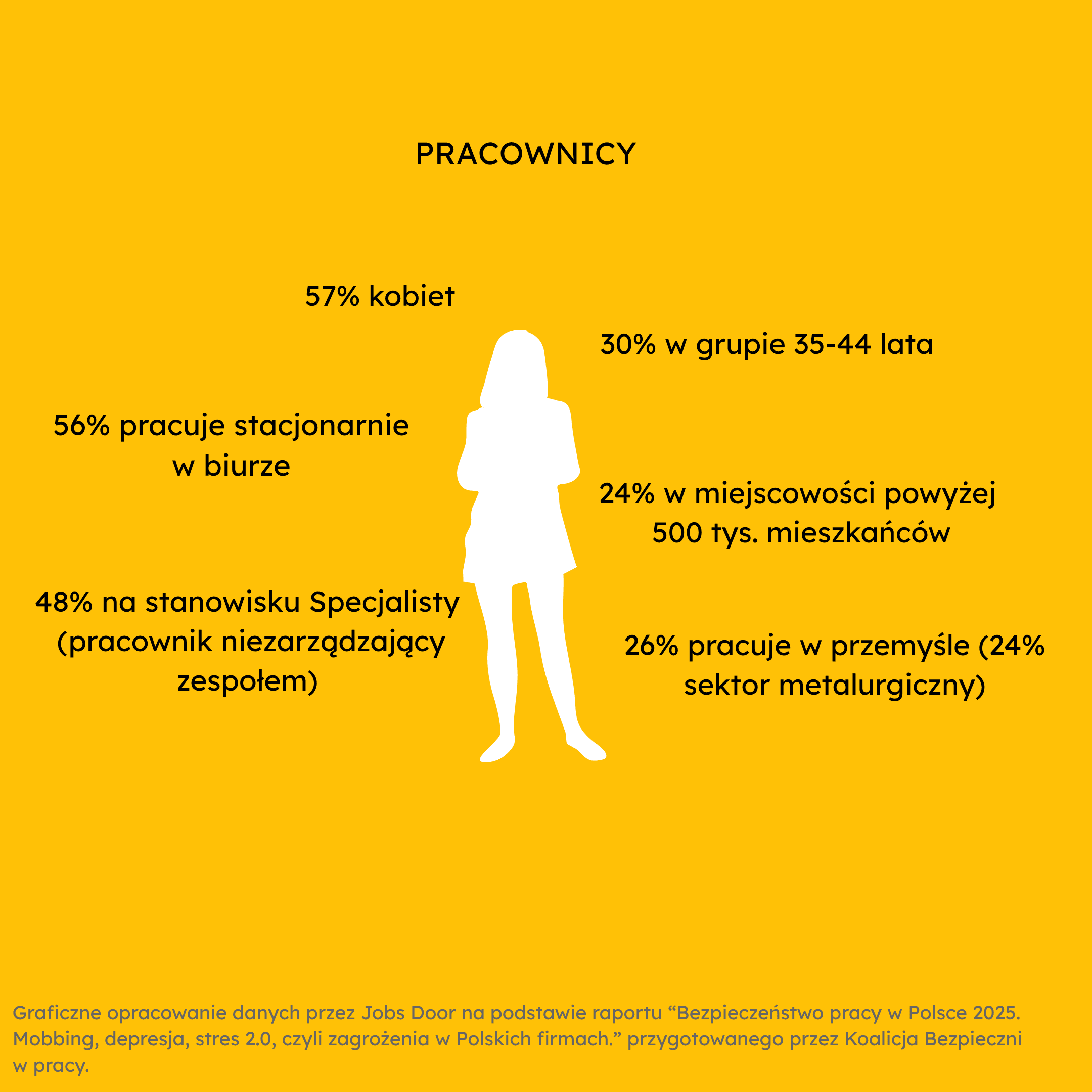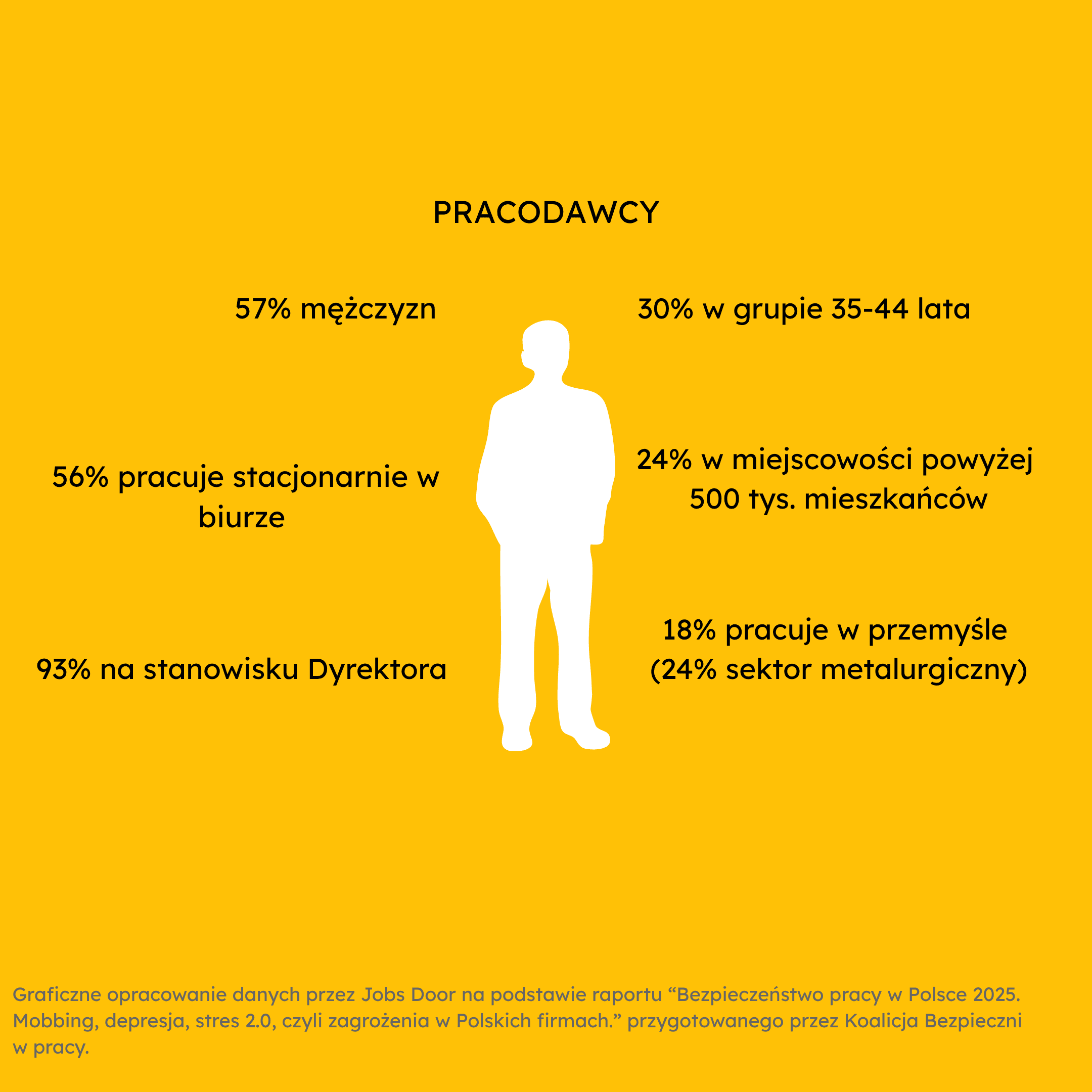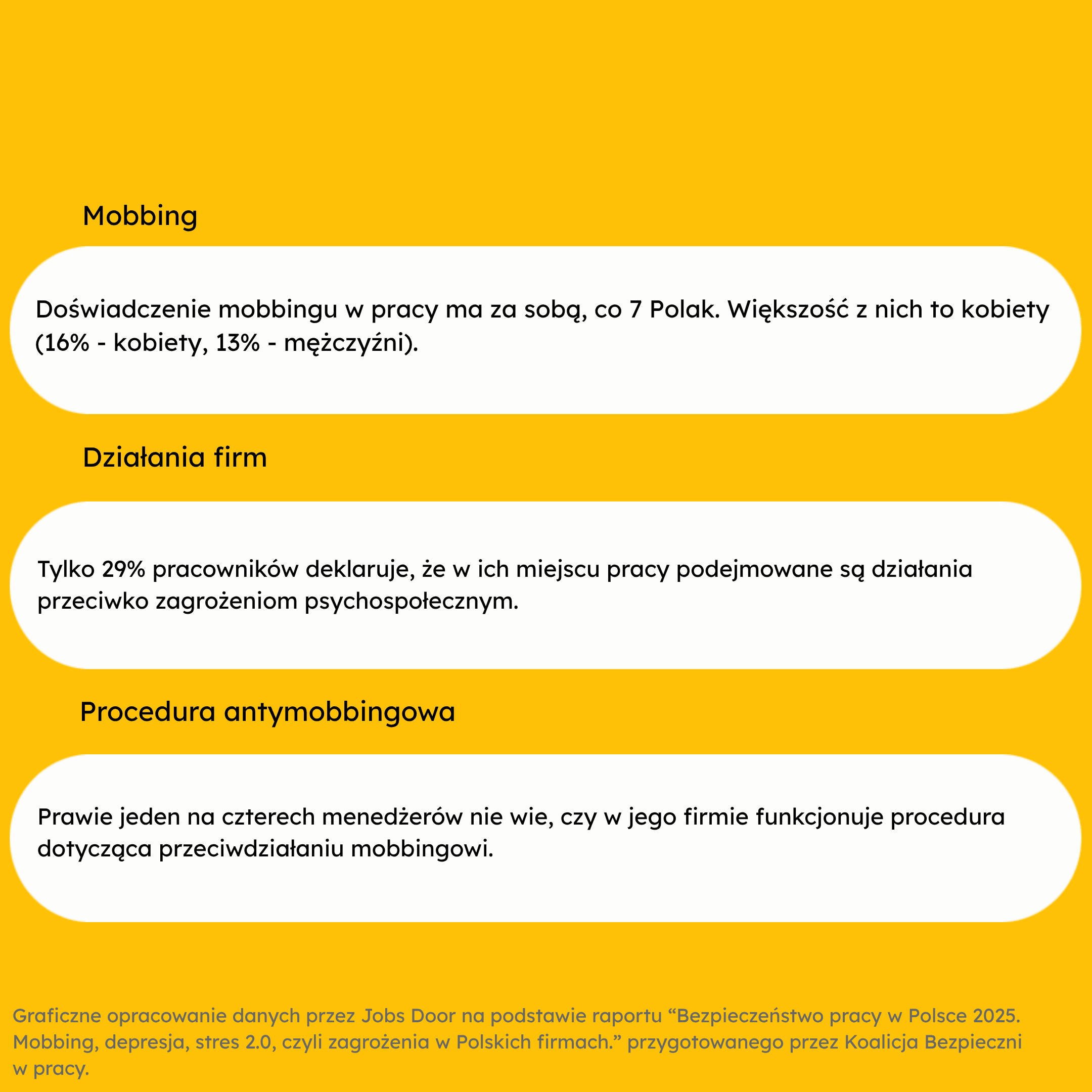Competition, artificial intelligence, a fast pace of work and even toxic behaviors of a co-worker... These are all things that can quickly destroy us in the workplace. However, this does not have to be the case if we take a serious look at how the Polish working environment reacts to changing socio-economic conditions, how it responds to problems in its own home, and whether it understands and promotes a healthy work culture.
Reading the report Occupational safety in Poland 2025. Mobbing, depression, stress 2.0, or threats in Polish companies. , Prepared by Coalition for Safe at Work, we can note that although our awareness of a healthy working environment and organizational culture is increasing, at the same time we still lack the tools to be able to create truly safe working conditions in Poland. And what does “safe” mean? After all, these are not only those that protect against injuries (although this is very important), but also those that prevent violence, mobbing and discrimination. The key issue is both awareness of the risks among employees and employers and the implementation of appropriate systems that can prevent negative phenomena in the workplace, but also react to them in a professional and fast way. Occupational safety understood in this way is of great importance for the development of companies and employees, which translates into the entire development of our economy. Why? In the era of mental crises and the rapid pace of development, the safety of employees should be of particular importance - the quality of work depends on their condition, as well as the turnover of people in the company, which translates into further development. According to the definition of the International Labor Organization, psychosocial risks include: high demands, violence, unclear distribution of roles, little control over work, harassment, job insecurity and insufficient pay. These are the results that often result from maladjusted requirements and organization of work with real possibilities, needs and expectations of the employee. And it is precisely the psychosocial threats that, in addition to mobbing, are important elements of education in the work environment. The price that can be paid for the consequences of both mobbing and psychosocial risks is high; for employees it is a loss of physical and mental health and for employers less company performance and a deterioration in the quality of work.
Silhouettes of respondents


Mobbing: can we perceive and define it?
term mobbing has become quite popular lately - it is increasingly appearing in commercial media and is no longer just the subject of social or psychological research. Also in Jobs Door A series of articles on this issue has been published, which you can read here: Mobbing at work: causes and effects, Mobbing at work: countermeasures and help tools.
Currently, when this concept has become significantly widespread, it is worth considering whether we really know its exact definition. This is exactly what respondents were asked in the report. Although comparing the results with the 2019 study, it can be seen that employees were more likely than employers to associate the concept of mobbing, in 2025 this trend has changed - today it is managers who are more likely to declare knowledge of the term (only 21% do not know it). At the same time, the percentage of employees associating the phenomenon of mobbing increased from 16% to 31%.
However, as highlighted in the report; associate it's one thing, and understand is the second. Who better to define mobbing? The answer is: managing. Although at first most of the subjects confirmed that they had met this term, in the case of clarifying its meaning, the results were already much weaker. Certainly an important conclusion is the fact that today, after six years, it is the management that is more familiar and better understood the concept of mobbing. Presumably, this has been influenced by increasing pressure on boards to pay more attention to the issue, as well as wider access to educational materials and training in this area.
It is also worth noting that anti-mobbing activities are increasingly being talked about in large, international companies, where such procedures are usually enshrined in organizational policy. On the Polish market, where more and more foreign companies operate, a peculiar new trend may have appeared. The development of scientific achievements is also important; more and more studies show the negative impact of mobbing both on employees and on the functioning and development of companies.
Main conclusions

What is mobbing for employees and what for managers?
Although, by definition, mobbing can occur in different directions - it can be a form of harassment both from a person in a higher position towards a subordinate, and vice versa - in practice it appears much more often in a relationship supervisors-employee. This is probably due to the fact that power provides greater opportunities for psychological violence and at the same time often involves less sense of responsibility for one's behavior. In the study, respondents who employees most often equated mobbing with persistent, long-term harassment and harassment that comes from an employer or supervisor towards a person in a lower position. This answer was given 21% of respondents, which was the most frequently chosen option out of all fifteen possible. In this edition of the study, however, employees also pointed out that mobber can also be a collaborator - this answer indicated 6% of respondents.
In turn managing persons They had a very similar understanding of the concept of mobbing. They also defined it as harassment, harassment, psychological violence or humiliation. Like employees, they decided that most often the perpetrator of mobbing is a person with power - employer or supervisor (This answer was given 15% of managers). Whereas only 4% of them indicated that a mobber could be an employee against another employee.
Mobbing: experience and reporting In order for the case to satisfy mobbing criteria, it should be borne in mind that actions such as harassment or psychological violence must be of a nature long-lasting and persistent. However, this does not mean that individual acts of aggression or inappropriate behavior can be considered acceptable; any form of psychological violence requires response and counteraction.
When it comes to results on mobbing experiences, in 2025 15% of employees He admitted that experienced mobbing many times. This is only a small - and rather disappointing - decrease compared to 2019, when the percentage was 14%. Much more often, employees indicated that they had witnessed mobbing - as many as 19% of respondents declared that they had observed such situations repeatedly. Among the managers 37% has remained Informed by employees about cases of mobbing, and some of them admitted that such reports appeared more than once. These results clearly show that the need for preventive measures and effective protective procedures is becoming increasingly urgent, both to prevent the phenomenon of mobbing and to provide real support to those who come into contact with it.
The key question, however, is who to turn to for help when we experience mobbing? Especially considering the fact that a mobber can be a superior person. In 2025, employees were asked about their behavior in a situation of witnessing mobbing. Most often, they stated that they would report the matter to a supervisor or HR department, talk to a person experiencing mobbing to show support, or respond directly to the perpetrator. Some respondents also indicated the possibility of anonymous reporting, which seems to be the most comfortable option from the point of view of a person experiencing mobbing at work. One in ten employees admitted that they would start looking for a new job first, and 9% saw it as the next step after observing undesirable behavior. This also shows that there are still no adequate systems in place in many companies that would help to “catch” the perpetrator of mobbing, solve the case, prevent the situation from developing and thus prevent the employee from being fired. In turn, managers, noticing a case of mobbing, most often declared that they would report the incident to the supervisor or HR department, talk to the injured person, as well as with the employee accused of misconduct. Many also pointed to the need to talk to the entire team to clarify the situation together and prevent it from developing further.
Anti-mobbing activities
As we can see, mobbing is becoming an increasingly noticeable and widely discussed problem. The growing awareness of its existence and the ability to properly define this phenomenon are crucial — they open the way for further work on building a healthier organizational culture. However, in order to achieve real progress in this area, two parallel actions are necessary. Firstly, updating and clarifying the definition of mobbing in the law so that it better reflects the contemporary realities of the work environment and facilitates the enforcement of liability. Secondly, the systematic integration of anti-mobbing activities into the organizational structures of companies, so that they constitute a permanent, mandatory element of internal policy and management culture.
In 2025 39% of employees said they did not know if there was an anti-mobbing procedure in place in their workplace, while 37% confirmed that it existed. Despite this uncertainty, as many as 63% of employees declared that they would know how to act if there was a mobbing in their company. Among the managers the situation looks a little different. More than half (52%) confirmed that their organization has an anti-mobbing procedure in place, but 25% have no knowledge in this regard. In addition, 51% of managers indicated that they had received information from the company on how to act in case of suspected mobbing.
Chief Labour Inspector, Marcin StaneckiThe report acknowledges that the State Labour Inspectorate more and more people come forward who consider themselves victims of mobbing. At the same time, he points out that not all of these people correctly understand the meaning of this concept, often reporting cases of incidental conflicts or situations that do not meet the legal criteria of mobbing. Despite this, Stanecki emphasizes both the importance of the problem on the Polish labor market and the need to introduce legislative changes that could more effectively protect employees and improve the process of processing such applications.
However, the other reports concern real problems that should not occur in the workplace. Neglect of employees during working hours leading to their low self-esteem or resulting health problems are phenomena that should be effectively and quickly eliminated. However, the current legislation provides little support to those affected by such actions. This is not only about the effective enforcement of claims, but also the widespread prevention of mobbing by developers, which is why the initiative of the Ministry of Family, Labor and Social Policy aimed at simplifying the rules in this area is important. We propose that the new regulation includes a provision allowing labor inspectors to require employers to create anti-mobbing procedures, which do not occur in every other company controlled by us. In practice, it turns out that the people employed there do not even know about it.
- Marcin Stanecki, Chief Labour Inspector in the report Occupational safety in Poland 2025. Mobbing, depression, stress 2.0, or threats in Polish companies.
summary
The phenomenon of mobbing is still one of the most serious challenges of the Polish labor market. Although awareness of its existence and understanding of the mechanisms of psychological violence are steadily increasing, the data show that the scale of the problem remains significant. More and more employees declare that they have encountered or witnessed mobbing, as well as that they can recognize and name this phenomenon. At the same time, many are still unsure whether anti-mobbing procedures are in place in their companies or how to react in the event of such situations. Reports also indicate that managers are more likely than in previous years to see the importance of countering mobbing and declare their readiness to respond. This is a positive signal, but still not enough. What is needed is not only greater education and social sensitivity, but above all systemic solutions that guarantee transparent rules of conduct and real protection for those who experience violence in the workplace. Only a combination of legislative changes with the real involvement of employers can have a lasting effect - creating jobs where the respect, safety and well-being of employees are real value, not just written into the rules.
Sources:





